Brian Branciforte, Florida's Wildlife Legacy Initiative Leader, Florida Fish and Wildlife Conservation Commission
A string of acronyms. Technical jargon. A map legend with 10 colors. Too many words squeezed into a slide. A graph that can’t be read.
We all have witnessed it and are probably guilty of it at one time or another: Concentrating our message on what the information is, rather than how it is told to the audience. As conservation professionals, we work in a field that has only recently adapted to incorporating social science and human dimensions into an arena once primarily about working with wildlife and nature – and away from people.
Yet the field of conservation has evolved, and we need to adapt our approach to conservation communication as well. Science translation is the ability to turn data, figures and technical information into an easy to understand account. Beyond the facts, science communication needs to be a relatable story, something that connects on a personal level. Coupling science translation and a conservation narrative is the way to connect conservation issues to people’s lives, values and decisions.
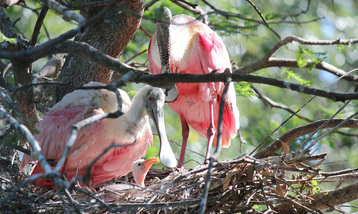 Among the biggest victims of conservation
communication discord are the thousands of fish and wildlife species under
state management jurisdiction that are not hunted or fished (so much so that
after all these decades, professionals still can’t agree what to call them e.g.
nongame, wildlife diversity, species of conservation need, etc.!).
Above: Roseate spoonbill adults attend to their young. As the name implies, the roseate spoonbill has a large, spoon-shaped bill, which it sweeps back and forth in shallow water to capture prey. FWC Photo by Claire Sunquist Blunden.
With the recent announcement of the Recovering America’s Wildlife Act and the recommendations of the Blue Ribbon Panel (see the below article for more information), the conservation community again faces a communication challenge front and center: explaining the relevancy of wildlife conservation amid societal changes and the importance of providing dedicated, sustainable funding for all wildlife.
While our natural resources face increased threats and uncertainty, it is vital to explain science into a digestible conservation narrative. This holds true for any audience, whether it’s the local garden club or our elected officials. We need to be able to clearly articulate issues, define solutions, measure success and connect fish and wildlife’s importance to people’s lives and values.
Now is the time to paint the big picture of why conservation matters with a unified message and an identifiable wildlife brand.
|
Back to top
Florida’s
Wildlife Legacy Initiative is excited to announce
projects recently selected to receive State Wildlife Grant funding! During the
past year, FWLI has worked with numerous external and internal partners in
developing project scopes of work, drafting and posting announcements, and
reviewing submissions. FWLI’s Goal Teams developed the following projects
through both the general and targeted processes. The proposed awards,
listed below, total $1.4 million and will help FWLI achieve its 2012 to 2017 goals by implementing the State Wildlife Action Plan. All projects are expected to begin this summer.

FWLI thanks the FWC staff from many sections and our external
partners, without whom the latest State Wildlife Grants cycle would not have
been successful. FWLI also thanks the U.S. Fish and Wildlife Service’s Florida
field offices and the Region 4 office in Atlanta for assistance and providing
the funding that makes these projects possible.
If you are interested in
State Wildlife Grant funding, contact Florida’s Wildlife Legacy Initiative.
Back to Top
Kevin Oxenrider, Assistant Regional Species Conservation Biologist, FWC
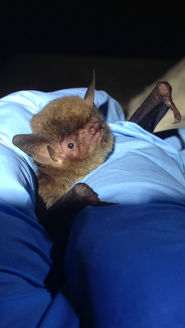 Little
is known about the life history of the Rafinesque’s big-eared bat, a species identified as a Species of Greatest Conservation Need in Florida’s State Wildlife Action Plan.
Biologists
with the Florida Fish and Wildlife Conservation Commission (FWC) are working to
conserve this and other bat species in the FWC’s North Central
Region.
Left: An adult southeastern myotis (Myotis austroriparius) captured at the Austin Cary Memorial Forest. Latex gloves are worn and changed between bats to help reduce the risk of spreading White Nose Syndrome, a fungal disease that has caused unprecedented mortalities in bat populations throughout the eastern US and Canada. WNS has not been detected in Florida to date. FWC Photo by Kevin Oxenrider.
Currently, nine of the 10 species of bats thought to occur in this region are listed as Species of Greatest Conservation Need: southeastern myotis, tricolored bat, big brown bat, eastern red bat, Seminole bat, northern yellow bat, hoary bat, Rafinesque’s big-eared bat and Brazilian free-tailed bat. But without knowing more about the life history and distribution of these species, biologists cannot create effective conservation and management strategies for bats in the region.
To fill data gaps for these bats, biologists have been conducting mist netting and acoustic surveys to locate Rafinesque’s big-eared bats and other bats on conservation lands in the region. To date, over 200 bats have been captured in mist nets, and over 6,000 bat calls have been collected during acoustic surveys on three conservation lands, Alachua County’s Newnans Lake Conservation Area, Austin Cary Memorial Forest in Gainesville and Levy County’s Andrews Wildlife Management Area in Trenton.
|
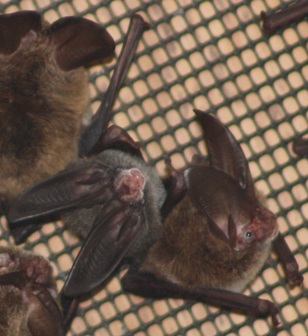
Right: An adult and juvenile Rafinesque's big-eared bat (Corynorhinus rafinesquii) hang from the ceiling of an artificial roost at the Lower Suwannee National Wildlife Refuge. FWC Photo by Kevin Oxenrider.
Additionally, biologists worked with staff at the Lower Suwannee National Wildlife Refuge to develop and implement a monitoring protocol to better understand where Rafinesque’s big-eared bats roost and form colonies, and how this behavior varies by season. This is a rare opportunity, since the Rafinesque’s big-eared bat colony at the refuge represents one of only a few colonies known in Florida. Biologists were able to obtain acoustic reference calls from Rafinesque’s big-eared bats at this location, important because foraging habitats and call characteristics of Rafinesque’s big-eared bats make them difficult to detect acoustically.
Survey efforts and Rafinesque’s big-eared bat colony monitoring will continue, and the biologists plan to expand these efforts to additional conservation lands within the North Central Region.
Go to MyFWC.com/Bats for more on Florida’s bats.
|
Back to Top
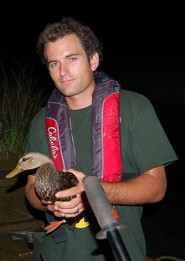 Dan O’Malley (pictured right) is the new Wildlife Legacy Biologist in
the Florida Fish and Wildlife Conservation Commission’s South Region. Dan has
been with FWC since March of 2016. Previously Dan worked as a field biologist
for the Louisiana Department of Wildlife and Fisheries in its Natural Heritage
Program. Dan received his B.S in Ecology and Evolutionary Biology from
Tulane University and completed his M.S in Marine and Environmental Biology
from Nicholls State University. While in Louisiana, Dan gained experience
working with the Louisiana State Wildlife Action Plan and is a contributing
author on the 2015 revision of the plan. Dan’s diverse background and
passion for wildlife conservation makes him a valuable asset to South Florida
and the FWC! He is leading the implementation of FWLI’s Marine
Goal, which focuses on coral reef restoration. In his spare time Dan
is an avid birder and SCUBA diver. We are excited to have him on board. If
you are in the South Regional Office, please stop by and say hi!
|
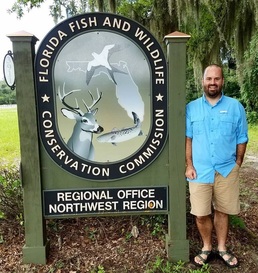 Thomas Kuhn (pictured left) is the new Wildlife Legacy Biologist in the FWC’s
Northwest Region. Thomas recently joined FWC as of August 12th and
is the newest team member of FWLI. He relocated to Panama City from Statesboro, Georgia where he was finishing his coursework to
receive a M.S. in Biology with a focus on fish ecology from Georgia Southern
University. Thomas is scheduled to defend his thesis this fall. Originally
a Kansas native, Thomas also received B.S. degrees in
Biology and History from Kansas State University. Thomas will be leading
the implementation of FWLI’s Freshwater
Goal in the Panhandle, which focuses on improving hydrologic conditions,
water quality, and physical habitats in freshwater systems. Thomas enjoys
SCUBA diving, snorkeling, exploring and spending time with his family in his
spare time and is very eager to learn more about the Florida Panhandle. If you
are in the Northwest Regional Office, please stop by and say hi!
To find the FWLI staff member in your area, please visit:
http://myfwc.com/conservation/special-initiatives/fwli/contact/
|
Back to Top
“A
lot is at stake if we don’t act soon. For every species that is thriving in our
country, hundreds of species are in decline. These recommendations offer a new
funding approach that will help ensure all fish and wildlife are conserved for
future generations, “said former Governor of Wyoming, David Freudenthal,
co-chairman of the Blue Ribbon Panel. “We need to start down a new path where
we invest proactively in conservation rather than reactively.”
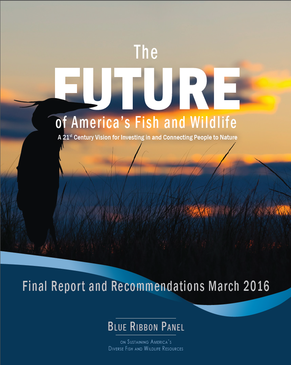 In March, the Blue Ribbon Panel on Sustaining America’s Diverse Fish and Wildlife Resources wrapped up a year-long effort to recommend a new mechanism to more equitably and comprehensively finance funding to help all fish and wildlife and prevent more species from becoming imperiled or endangered. The 27-member panel recommended that the U.S. Congress dedicate up to $1.3 billion annually in existing revenue from the development of energy and mineral resources on federal lands and waters to the Wildlife Conservation and Restoration Program.
The panel’s co-chairs, John Morris, founder and CEO of Bass Pro Shops, and Freudenthal, announced the Panel’s recommendations at the Teaming With Wildlife Fly-In event in Washington, D.C.
Read the Panel’s report here. View the press conference here.
The goal of $1.3 billion is based on a 2012 Southwick & Associates survey, and represents the cost to implement 75% of all State Wildlife Action Plans (see Florida’s 2012 plan here). Collin O’Mara, president & CEO of the National Wildlife Federation and a Blue Ribbon Panelist, spoke at the press conference saying, “This is different (than previous efforts) because we have business leaders saying the same things … We need a better way (to conserve fish and wildlife).” For more on the history of these previous efforts, visit Teaming With Wildlife.
The Florida Fish and Wildlife Conservation Commission discussed at its April meeting the panel’s recommendations. “This is like the hole in a doughnut,” said Commission Chairman Brian Yablonski. “We have financial resources dedicated to game species and endangered species but not for the many species in the middle.” Florida has identified many of its non-game species (or, “the species in the middle”) as species of greatest conservation need.
Read the press release here.
Most recently, Congressman Don Young (R-AK) and Congresswoman Debbie Dingell (D-MI) introduced the bipartisan bill Recovering America’s Wildlife Act (H.R. 5650), which implements the recommendations of the Blue Ribbon Panel. The bill would fund the currently unfunded Wildlife Conservation and Restoration Account - $650 million from existing revenues from energy development on the outer continental shelf and $650 million from existing revenues from mineral development on federal lands. These funds currently go into the U.S. Treasury. States would use the funds to implement conservation actions identified in the State Wildlife Action Plans as well as to enhance wildlife-related recreation and conservation education.
Previous Legacy Newsletter articles about the Blue Ribbon Panel: Winter 2015 issue and Winter 2016 issue.
|
Back to Top
Erin McDevitt, Southeast Marine Habitat Manager, FWC
Dan O'Malley, South Regional Wildlife Legacy Biologist, FWC
The 2005 State Wildlife Action Plan
identified anchor damage and boat groundings as threats to coral reef
communities and proposed using mooring buoys at impacted sites to mitigate
these threats. Mooring buoys facilitate and promote access to coral reefs,
while preventing further anchor damage and allowing recovery of damaged corals.
Moorings are used extensively in other southeast Florida counties, but there
were no moorings in Palm Beach County as of 2009. Due to the proximity of the
Gulf Stream to the Palm Beach County coastline, it is impractical to place
moorings on deeper reefs because of strong currents and the dangers associated
with mooring in such conditions. Nearshore reefs, however, do not experience
such strong currents, thus making mooring buoys feasible.
In 2009, the Florida Fish and
Wildlife Conservation Commission, Palm
Beach County Department of Environmental Resources Management (PBC ERM), and Fish & Wildlife Foundation of Florida cooperatively designed a Palm Beach
County Mooring Buoy Project to protect Palm Beach County’s most sensitive nearshore
shallow coral reefs. Reefs identified by the project suffered from damage
caused by the deployment of boat anchors. This project also was a response to public
requests for moorings, both to increase ease of access to the reefs and to provide
an ecologically responsible alternative to anchoring.
Breaker’s
Reef is a popular diving and snorkeling site about a mile offshore from The Breakers Hotel in the
town of Palm Beach. This highly diverse reef is dominated by soft corals and
sponges, but stony corals also are present along with 57 species of fish,
including recreationally sought species of snapper and grouper. Fourteen species of invertebrate Species of Greatest Conservation Need have been documented on the reef. Sea turtles,
especially green turtles, frequent shallow coral reef habitats to forage and often
are observed at Breaker’s Reef.
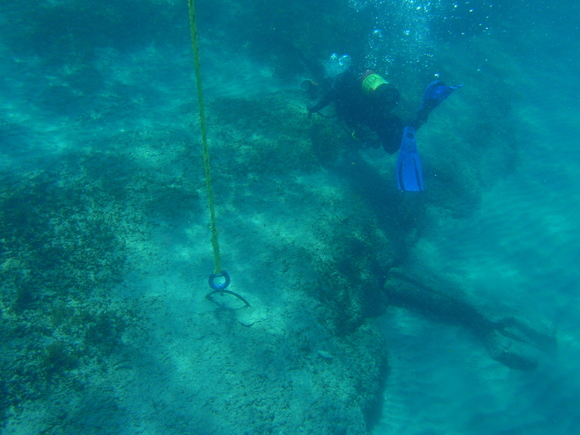 Newly installed mooring buoy at Breaker's Reef, FWC Photo by Erin McDevitt
Breaker’s Reef was chosen as
the location to “kick start” the Palm Beach County Mooring Buoy Program and was awarded a State Wildlife Grant (SWG) in 2009. The goal of the project was
to prevent further damage caused by anchoring activities and provide an
opportunity to recover from previous impacts. It was achieved by installing 16 permanent
mooring buoys. The SWG-funded project included monitoring the condition of reef resources in the vicinity of the mooring
buoys and educating the public about the buoys by creating and distributing brochures
for boaters featuring a map of the mooring field and instructions on proper use
of the mooring buoys.
The
moorings were well-received and are frequently used by the public. Monitoring
of buoy usage during the project qualitatively showed that buoy use was favored
over anchoring. Over the course of 20 observations, 42 boats were observed
moored on the buoys and only 10 anchored in the vicinity of the buoys. While
reef recovery can take decades and cannot yet be documented, during the monitoring
phase of this project, there was no new anchor damage recorded on the reefs in
the vicinity of the moorings. Partial burial of the reef resulting from a
nearby beach nourishment project complicated efforts to monitor the impact of
the mooring buoys on the condition of the reef.
Expanded
public support and enthusiasm for expansion of the Palm Beach County Mooring
Buoy Program was a significant outcome of this project. Based on the success of
the SWG-funded moorings at Breaker’s Reef, PBC ERM was awarded an FWC Boating
Improvement Grant in 2011. Through this grant, additional mooring fields were
installed throughout Palm Beach County. The SWG-funded Breaker’s Reef Mooring
Buoy project fostered funding and support for and boater use of moorings now
protecting other reefs. Currently, Palm Beach County has a total of 38 buoys in
five separate mooring fields distributed from Jupiter to Boca Raton.
View Palm Beach County's Mooring Buoy Program Fact Sheet here.
Back to Top
We don’t always take enough time to celebrate hard work and amazing
accomplishments. Florida’s Wildlife Legacy Initiative is recognizing the
following principal investigators who finished their State Wildlife
Grant-funded projects in the past six months. These projects demonstrate the
wide variety of conservation efforts taking place in Florida: research,
on-the-ground restoration and management, mapping and monitoring. For more
information on the following projects, please contact Andrea.Alden@MyFWC.com or Robyn.McDole@MyFWC.com.
Congratulations to all on work well done!
1. Lake Wales Ridge State Forest Helicopter Burn in Scrub, Sandhill, Dry Prairie and Wet Flatwoods - Corey Walk, Florida Forest Service
Funded through the Terrestrial
Goal, the project’s goal was to conduct prescribed
burns on approximately 4,000 acres within Lake Wales
Ridge State Forest. From
July 2013 through April 2016, the Florida Forest
Service surpassed the goal burning a total of 6,928 acres on three separate tracts at Lake Wales
Ridge State Forest. This was accomplished through six helicopter-conducted
burns combined with hand ignition techniques within management blocks. (View the
abstract)
|